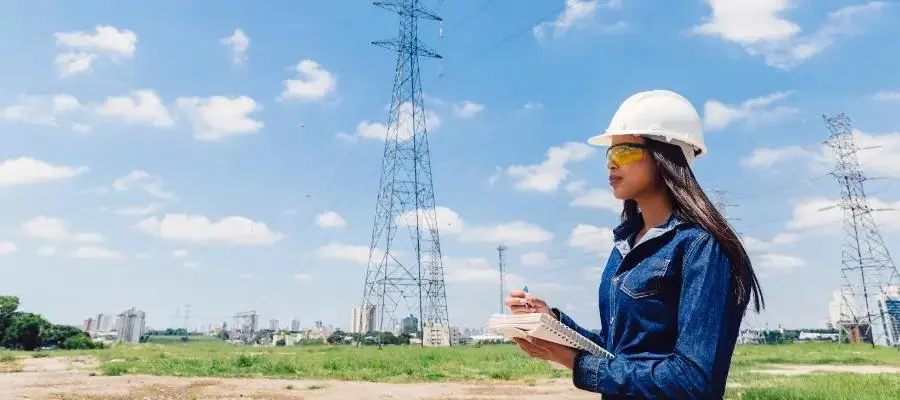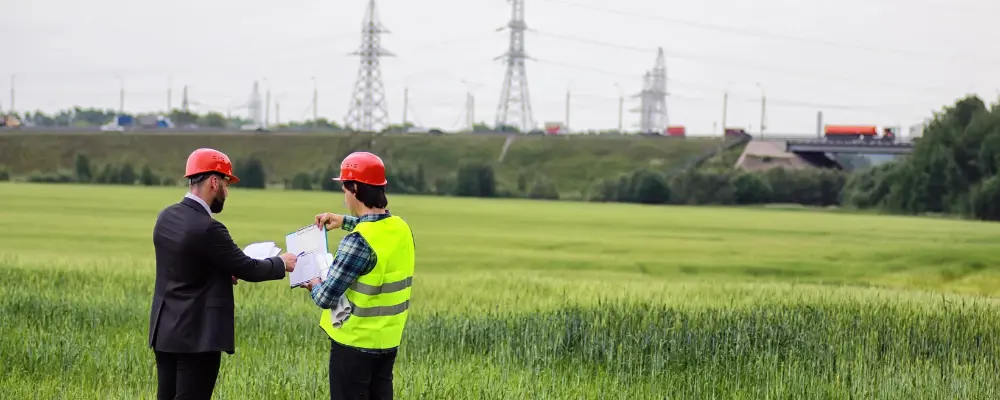Construction projects are very important for a country’s growth. Like two sides of a coin, Construction projects have advantages and drawbacks.
The environment had been damaged significantly in the past when construction projects and development activities were initiated without considering the environmental consequences. Thus, assessing the environmental impacts and increasing environmental compliance in construction activities becomes critical as societies become concerned with sustainable development.
In this blog with Brick & Bolt, you will understand the Environmental Impact Assessment (EIA) process for construction projects, its importance, key steps, and benefits.
What is Environmental Impact Assessment (EIA)?
Environmental Impact Assessment (EIA) is a process that evaluates the feasible ecological impacts of a proposed project or development, considering its effect on the environment, people, and society before it’s built. This information is used to predict a project’s environmental impacts in the pre-planning stage so that decisions can be made to lessen the adverse impacts.
Importance of EIA in Construction Projects
Any construction project has to be managed for timely completion and be within a fixed budget. Without proper management, any construction project, small and large-scale, may go wrong during any project stage.
Following are some of the importance of EIA:
- An EIA is like a check-up for the environment before you build anything. It helps identify potential problems early on so you can fix them before they happen.
- EIA for building construction projects promote “green” construction by making sure projects are built in a way that protects the environment. This can even save money in the long run!
- It’s like a law – many construction projects need government approval based on an EIA.
- EIAs are a tool to predict how construction might affect the environment and the people around it. This allows for better planning to avoid issues.
- By conducting an Environmental Impact Assessment (EIA) for construction projects with the assistance of an EIA consultant, builders can identify strategies to reduce environmental impact and promote public health.
- The environmental impact assessment process helps you understand nature’s importance and how to protect it while still building the things we need.
Key Steps in Environmental Impact Assessment for Construction Projects

1. Screening
You will determine whether an EIA for construction projects is necessary or not through this initial step of the process. Examining the positive and negative effects, as well as the qualitative and quantitative effects, of the suggested project is the main goal of this study. By analysing the project’s size, location, and type of development, the environmental impact is estimated. Two primary methods for screening are thresholds and a case-by-case analysis for the specified criteria. Following the screening procedure, an Initial Environmental Examination or Evaluation (IEE) is produced. This document is the basis for determining whether or not an EIA is required.
2. Scoping
The scoping stage, done with the help of an EIA consultant, defines what the assessment will cover, its goals, and its limits. This phase starts by clearly describing the construction project, including its purpose, size, and location. It also identifies potential environmental impacts, focusing on sensitive environmental areas and engaging with stakeholders to understand local concerns. Basic information on existing ecological conditions is gathered, and the geographic and time boundaries for the evaluation are set. Scoping is a key planning phase that ensures the assessment focuses on relevant environmental issues and stakeholders, guiding the next steps effectively.
3. Impact Identification and Prediction
In this section, thorough assessments of the planned project’s potential impacts on environmental and socioeconomic conditions will be performed. Assessing their severity also helps identify mitigation measures to reduce those impacts. Ecological modelling and assessment tools will be used to predict the magnitude and extent of impacts.
Mitigation measures can include avoiding the impact altogether, reducing the severity of the effect, or restoring the environment after the impact has occurred.
4. Mitigation and Monitoring
In this step, recommendations are given to offset the negative effects of the proposed building project on the environment, as shown by the impact assessment. Mitigation, which can also help illustrate the iterative nature of the EIA, refers to the actions done to lessen or eliminate the impacts that have been assessed above. Three types of mitigation strategies are available: compensatory (to reduce potential reactions), corrective (to place devices and equipment), and preventive (by arranging public awareness initiatives).
Monitoring is vital in upholding all the commitments outlined in the approved EIA. It is also crucial for detecting any changes in the environment and communities due to the project and other local and/or global events, such as shifts in livelihoods from economic crises, migration, or variations in water availability from droughts. Basic monitoring efforts will also continue after the project’s completion during project recovery.
Benefits of Environmental Impact Assessment
Environmental impact assessment (EIA) is a major process which presents multiple benefits for the sake of sustainable development:
1. Earlier Detection of Potential Environmental Impacts
Environmental impact assessment is a tool that methodically assesses proposed projects and developments. It recognises potential environmental impacts before they appear. This prevision helps decision-makers to take preventive measures, reduce harm, and protect natural resources.
2. Decision-making with Environmental Considerations
The Environmental Impact Analysis (EIA) ensures that environmental factors are included in decision-making. This means that environmental issues are considered alongside social and economic factors rather than being an afterthought. As a result, projects are planned and executed with a better understanding of their environmental effects, promoting the development of green buildings.
3. Keeping Ecosystems and Natural Resources Safe
EIA greatly helps protect ecosystems and natural resources in our world. High ecological value areas can be found by using Environmental Impact Analysis (EIAs) to assess possible development project impacts. This makes it possible to enact laws or other safeguards. Moreover, EIA mandates that our developers take actions to improve biodiversity in the area or repair harmed ecosystems.
4. Enabling the Growth of Sustainability
The concepts of sustainable development are in line with EIA. It guarantees that initiatives are socially and environmentally responsible in addition to being commercially feasible. Ecological Impact Assessment promotes initiatives that honour the environment’s carrying capacity, which contributes to the development of a more sustainable future. EIA contributes to addressing current requirements without sacrificing the capacity of future generations to address their own.
5. Incorporation of Public with Stakeholders
The public and stakeholders are encouraged to participate in the transparent EIA process. Various viewpoints are taken into account thanks to the involvement of multiple parties, including environmental organisations and local populations, through the EIA. This inclusiveness enhances public knowledge and comprehension of environmental challenges and supports decision-making. The benefits of environmental impact assessments (EIAs) go beyond reducing environmental damage and protecting our planet’s natural resources. They are essential to ethical and responsible development.
Challenges and Limitations

Although EIA has several advantages, it’s crucial to be mindful of its drawbacks:
1. The Consequences of Time and Money
Generally, an environmental impact analysis can be expensive. Additionally, it is time-consuming because it requires collecting and analysing data, consulting with the public, and satisfying legal requirements. Delays in the evaluation process may lead to project delays and higher costs.
2. Objectivity and Complications of Evaluations
Expert judgment is important when evaluating the potential environmental impacts in an Environmental Impact Assessment (EIA). Because environmental systems are complex, this can lead to different conclusions and interpretations. These assessments can be hard to understand and open to multiple interpretations, which can cause disagreements about their accuracy.
3. Possible Disagreements and Hold-ups
Conflicting interests between project supporters, nearby communities, environmental organisations, and government agencies can be found through an environmental impact assessment (EIA). Project delays or even legal conflicts may result from disagreements about the importance of environmental damage or the suitability of mitigation methods.
4. Gaps in Assessing Long-Term Environmental Effects
An EIA usually focuses on the direct impacts of a project. However, it might miss some effects, like cumulative and indirect ones that come from multiple projects or develop over time. This can lead to an incomplete understanding of the long-term environmental impacts of development.
5. Difficulties in Projecting Long-Term Effects
Forecasting how a project will affect the environment in the long run might be difficult. The way effects materialise over time can be influenced by variables such as population fluctuations, changing ecosystems, and climate change. Long-term effect estimates may not be as accurate as they may be if the EIA does not consider these dynamic elements completely.
It’s critical to take these drawbacks into account in the larger context of EIA. Even though EIA may have certain limitations, these are frequently outweighed by its ability to prevent or lessen substantial environmental impact.
Acknowledging these drawbacks promotes ongoing EIA process improvement.
Future Directions
As the construction industry evolves, the future direction of Environmental Impact Assessments (EIA) must be geared towards addressing emerging challenges and opportunities. This includes ensuring sustainable development through the inclusion of sustainable construction materials.
Integration of Advanced Technologies
Technological advancements will greatly impact the future of EIA in construction. The integration of Geographic Information Systems (GIS), remote sensing, and big data analytics will improve the accuracy and efficiency of environmental assessments. These technologies enable real-time monitoring and predictive modelling, allowing for more proactive and dynamic management of environmental impacts.
Emphasis on Climate Change Mitigation and Adaptation
Climate change is becoming a central consideration in EIA processes. Future EIAs will increasingly focus on assessing and mitigating greenhouse gas emissions from construction projects. Additionally, there will be a greater emphasis on designing structures that are resilient to climate impacts, such as extreme weather events and rising sea levels. This shift will necessitate the incorporation of climate risk assessments and sustainable design principles into the EIA framework.
Enhanced Stakeholder Engagement and Transparency
Future EIA practices will prioritise greater stakeholder engagement and transparency. With growing public awareness and concern about environmental issues, there is a pressing need for EIAs to be more inclusive and participatory. This involves not only consulting local communities and other stakeholders early in the project planning stages but also ensuring that EIA findings are accessible and comprehensible to the public.
Stronger Regulatory Frameworks and Standards
As environmental challenges intensify, there will be a push for stronger regulatory frameworks governing EIAs. Governments and international bodies are likely to implement stricter standards and compliance requirements, ensuring that EIAs are comprehensive and effective. This may include mandatory post-implementation monitoring and stricter penalties for non-compliance.
Focus on Circular Economy Principles
Incorporating circular economy principles into EIAs will become increasingly important. This involves evaluating the lifecycle impacts of construction materials and promoting sustainable building practices. By doing so, EIAs can help reduce waste and resource consumption, contributing to a more sustainable construction industry.
Conclusion
Environmental Impact Assessment (EIA) is a vital tool for promoting sustainable development and ensuring the responsible management of construction projects. Stakeholders can minimise harm to ecosystems, communities, and future generations by systematically identifying, assessing, and mitigating environmental impacts. Integrating EIA into construction practices is essential for building a more resilient and environmentally conscious world as we navigate the complexities of urbanisation and infrastructure development.
Read More: Bamboo As a Construction Material: Build Sustainable & Affordable Homes

